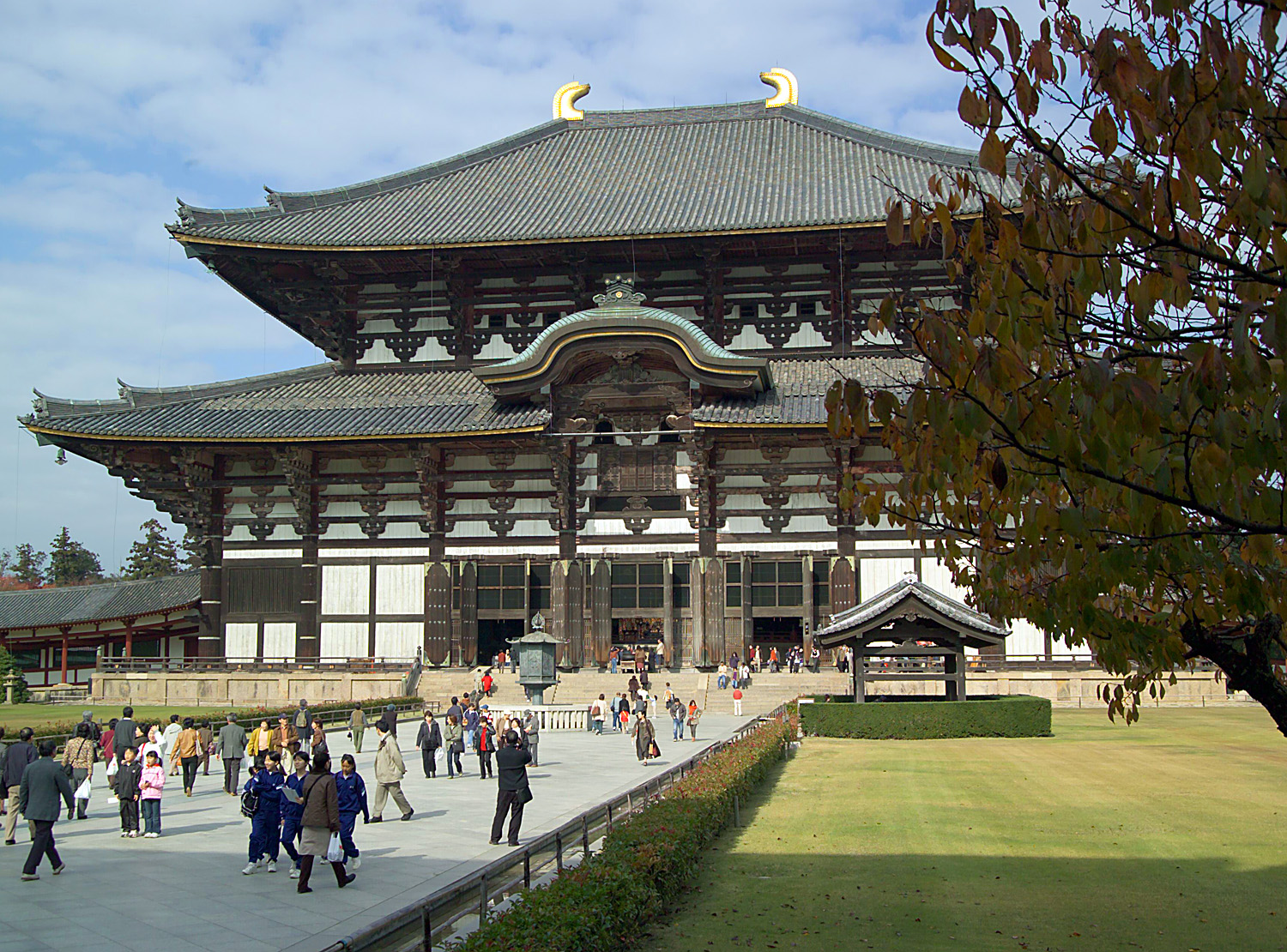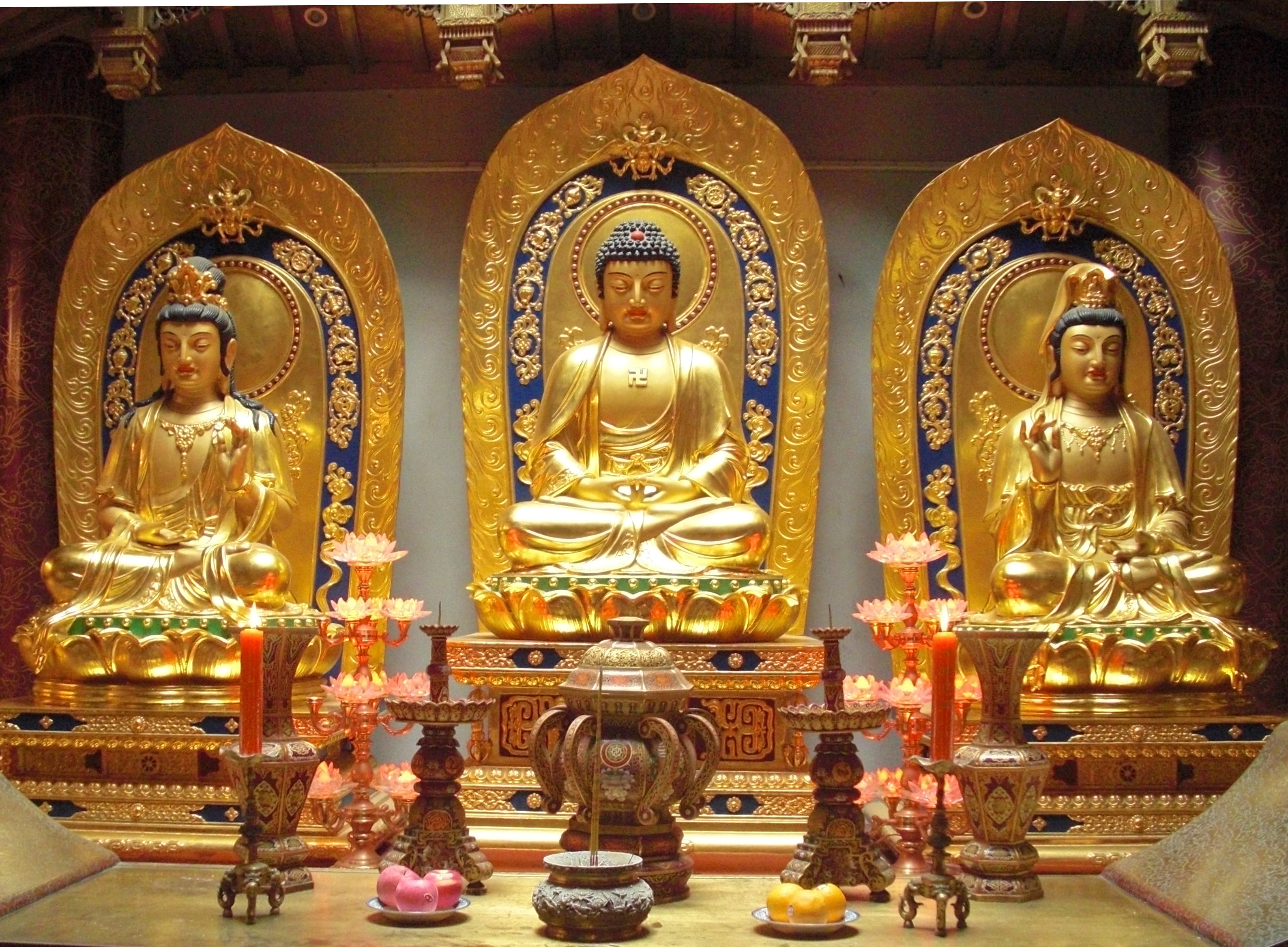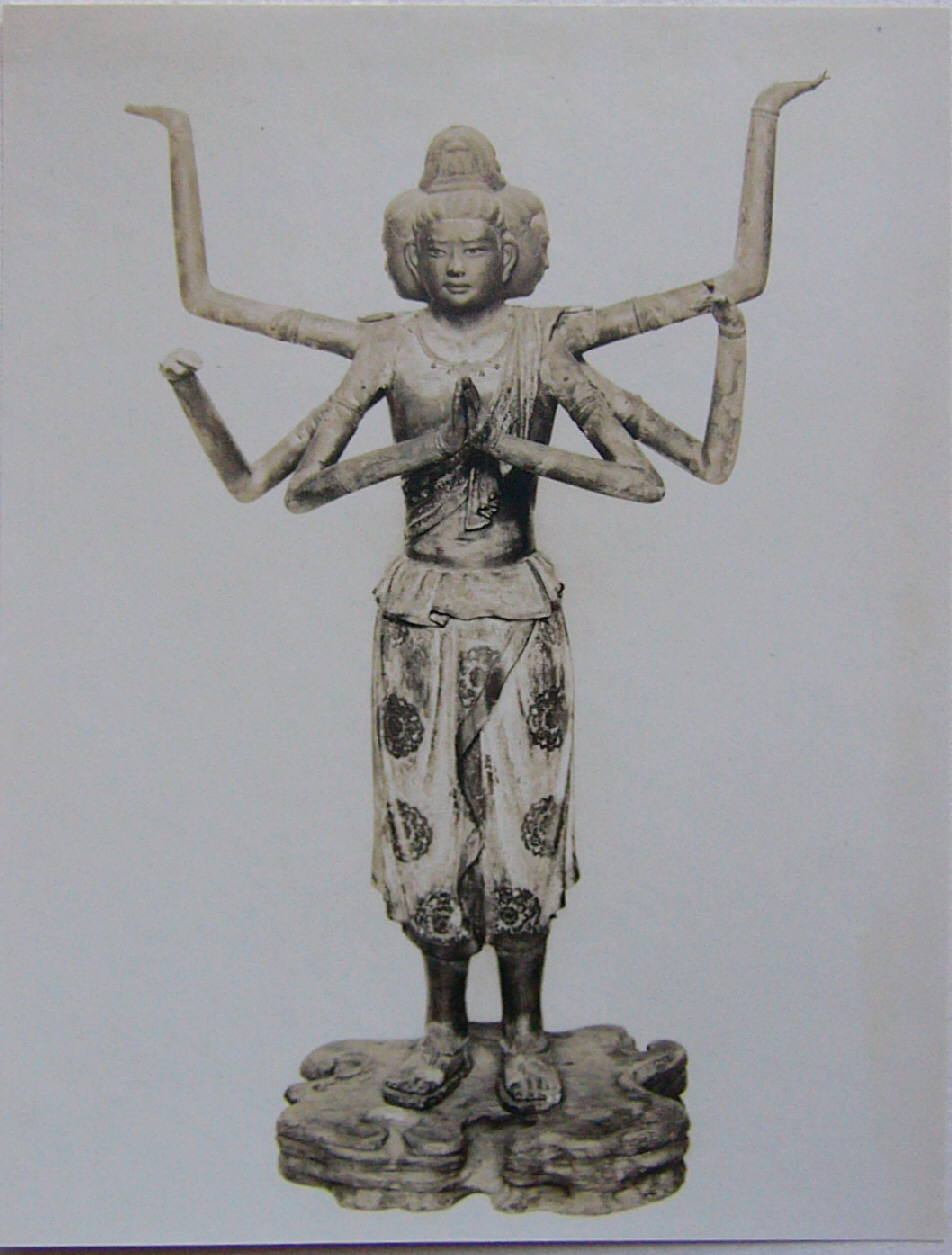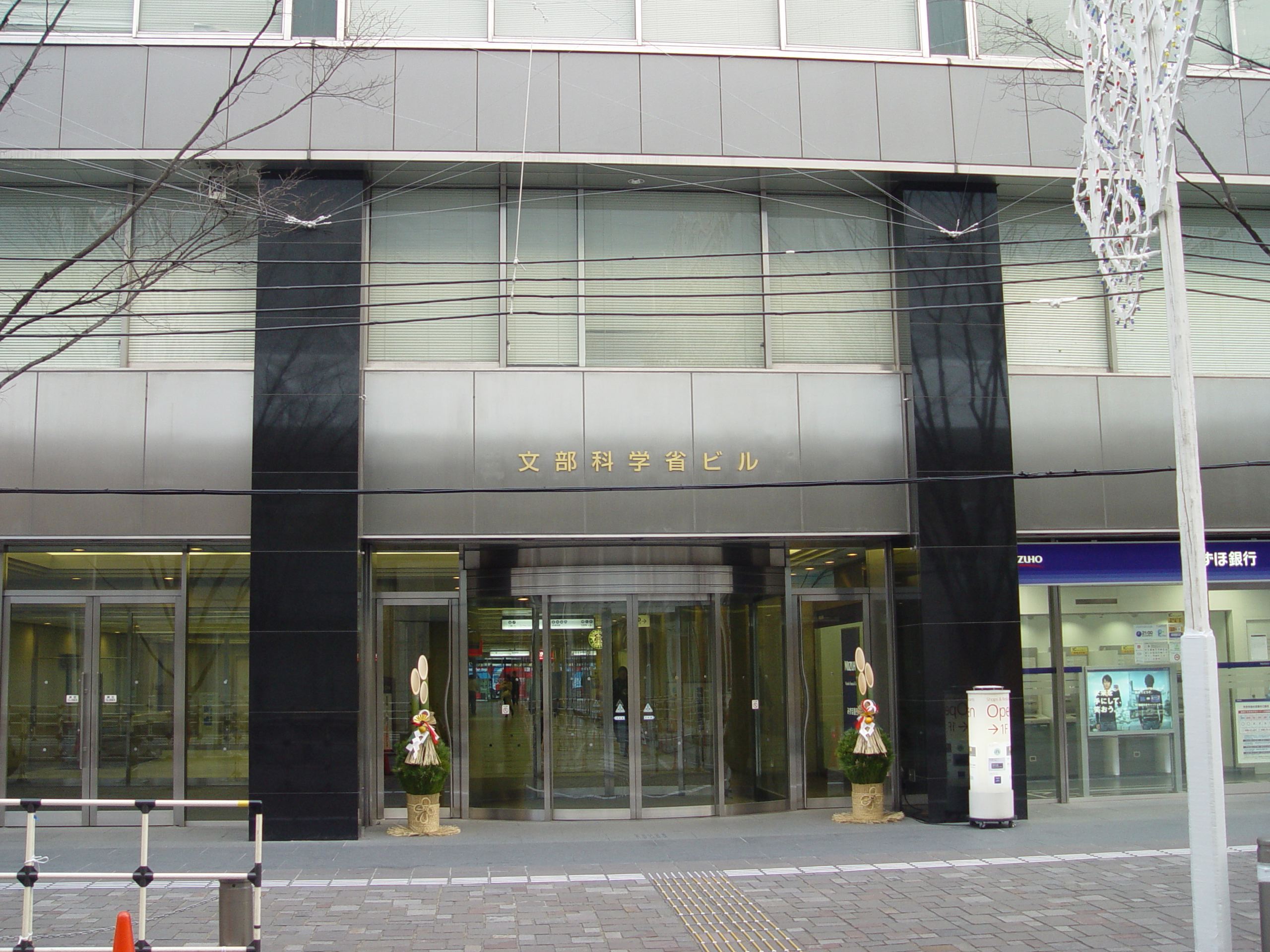|
Kōzō-ji (Kakuda)
is a Buddhist temple located in the city of Kakuda, Miyagi Prefecture, Japan. Kōzō-ji was founded in 819 AD by Tokuitsu, a monk of the Hōsso sect. It was restored in 1177 by the wife of Fujiwara Shuei, who erected the Amida-dō, which is the oldest building in the prefecture, and one of the very few Heian period structures remaining. In 1908 it was designated an Important Cultural Property. The wooden statue of Amida Nyorai seated on a lotus throne (1177), constructed using the ''yoseki-zukuri'' technique, was designated an Important Cultural Property in 1927. See also *Pure Land Buddhism *Japanese Buddhist architecture *Japanese sculpture *Important Cultural Properties of Japan *Northern Fujiwara The Northern Fujiwara (奥州藤原氏 ''Ōshū Fujiwara-shi'') were a Japanese noble family that ruled the Tōhoku region (the northeast of Honshū) of Japan during the 12th century as their own realm. |
Buddhist
Buddhism, also known as Buddhadharma and Dharmavinaya, is an Indian religion and List of philosophies, philosophical tradition based on Pre-sectarian Buddhism, teachings attributed to the Buddha, a wandering teacher who lived in the 6th or 5th century Before the Common Era, BCE. It is the Major religious groups, world's fourth-largest religion, with about 500 million followers, known as Buddhists, who comprise four percent of the global population. It arose in the eastern Gangetic plain as a movement in the 5th century BCE, and gradually spread throughout much of Asia. Buddhism has subsequently played a major role in Asian culture and spirituality, eventually spreading to Western world, the West in the 20th century. According to tradition, the Buddha instructed his followers in a path of bhavana, development which leads to Enlightenment in Buddhism, awakening and moksha, full liberation from ''Duḥkha, dukkha'' (). He regarded this path as a Middle Way between extremes su ... [...More Info...] [...Related Items...] OR: [Wikipedia] [Google] [Baidu] |
Heian Period
The is the last division of classical Japanese history, running from 794 to 1185. It followed the Nara period, beginning when the 50th emperor, Emperor Kammu, moved the capital of Japan to Heian-kyō (modern Kyoto). means in Japanese. It is a period in Japanese history when the Chinese influence on Japanese culture, Chinese influences were in decline and the national culture matured. The Heian period is also considered the peak of the Japanese Emperors of Japan, imperial court, noted for its Japanese art, art, especially Japanese poetry, poetry and Japanese literature, literature. Two syllabaries unique to Japan, katakana and hiragana, emerged during this time. This gave rise to Japan's famous vernacular literature, with many of its texts written by court ladies who were not as educated in Chinese as their male counterparts. Although the Imperial House of Japan had power on the surface, the real power was in the hands of the Fujiwara clan, a powerful Kuge, aristocratic family wh ... [...More Info...] [...Related Items...] OR: [Wikipedia] [Google] [Baidu] |
Japanese Buddhist Architecture
Examples of Buddhist architecture in Japan Japanese Buddhist architecture is the architecture of Buddhist temples in Japan, consisting of locally developed variants of architectural styles born in China.p=716/ref> After Buddhism arrived from the continent via the Three Kingdoms of Korea in the 6th century, an effort was initially made to reproduce the original buildings as faithfully as possible, but gradually local versions of continental styles were developed both to meet Japanese tastes and to solve problems posed by local weather, which is more rainy and humid than in China. The first Buddhist sects were Nara, Nara, Nara's six ,The six sects were called Sanron-, Jōjitsu-, Hossō-, Kusha-, Ritsu-, and Kegon-shū. followed during the Heian period by Kyoto's Shingon and Tendai. Later, during the Kamakura period, in Kamakura, Kanagawa, Kamakura were born the Jōdo and the native Japanese sect Nichiren-shū. At roughly the same time, Zen Buddhism arrived from China, strongly i ... [...More Info...] [...Related Items...] OR: [Wikipedia] [Google] [Baidu] |
Pure Land Buddhism
Pure Land Buddhism or the Pure Land School ( zh, c=淨土宗, p=Jìngtǔzōng) is a broad branch of Mahayana, Mahayana Buddhism focused on achieving rebirth in a Pure land, Pure Land. It is one of the most widely practiced traditions of East Asian Buddhism, Buddhism in East Asia. It is also known as the "Lotus School" (Chinese language, Chinese: 蓮宗; pinyin: ''Liánzōng'') in China or the "Nianfo, Nembutsu school" in Japan. East Asian Pure Land mainly relies on three main Mahayana sutras, Mahayana scriptures: the ''Longer Sukhāvatīvyūha Sūtra, Sutra of Amitayus'', the ''Amitāyus Contemplation Sūtra, Contemplation Sutra'' and the ''Shorter Sukhāvatīvyūha Sūtra, Amitabha Sutra''. The Pure Land tradition is primarily focused on achieving rebirth in a Buddhahood, Buddha's "pure land", a superior place to spiritually train for full Buddhahood, where one can meet a Buddha face to face and study under them without any of the distractions or fears of our world.Williams, Pau ... [...More Info...] [...Related Items...] OR: [Wikipedia] [Google] [Baidu] |
Technology Of Japanese Buddhist Sculpture
Technology is the application of conceptual knowledge to achieve practical goals, especially in a reproducible way. The word ''technology'' can also mean the products resulting from such efforts, including both tangible tools such as utensils or machines, and intangible ones such as software. Technology plays a critical role in science, engineering, and everyday life. Technological advancements have led to significant changes in society. The earliest known technology is the stone tool, used during prehistory, followed by the control of fire—which in turn contributed to the growth of the human brain and the development of language during the Ice Age, according to the cooking hypothesis. The invention of the wheel in the Bronze Age allowed greater travel and the creation of more complex machines. More recent technological inventions, including the printing press, telephone, and the Internet, have lowered barriers to communication and ushered in the knowledge economy. Whi ... [...More Info...] [...Related Items...] OR: [Wikipedia] [Google] [Baidu] |
Lotus Throne
The lotus throne, sometimes called lotus platform, is a stylized lotus flower used as the seat or base for a figure in art associated with Indian religions. It is the normal pedestal for divine figures in Buddhist art and Hindu art, and often seen in Jain art. Originating in Indian art, it followed Indian religions to East Asia in particular. The precise form varies, but is intended to represent the opening flower of ''Nelumbo nucifera'', the Indian lotus. In the traditional biographies lotus flowers sprung up at the Buddha's first seven steps, and in some Buddhist legends the baby Padmasambhava emerged from a lotus flower. The Indian lotus is an aquatic plant similar to a Nymphaeaceae, water lily, though not actually any close relation. It has a large, round, and flat Receptacle (botany), seed head in the centre of the flower, with initially small openings above each of the relatively small number of seeds. Among other unusual characteristics, ''nelumbo nucifera'' has partic ... [...More Info...] [...Related Items...] OR: [Wikipedia] [Google] [Baidu] |
Japanese Sculpture
Sculpture in Japan began with the clay figure. Towards the end of the long Neolithic Jōmon period, "flame-rimmed" pottery vessels had sculptural extensions to the rim, and very stylized pottery dogū figures were produced, many with the characteristic "snow-goggle" eyes. During the Kofun period of the 3rd to 6th century CE, haniwa terracotta figures of humans and animals in a simplistic style were erected outside important tombs. The arrival of Buddhism in the 6th century brought with it sophisticated traditions in sculpture, Chinese styles mediated via Korea. The 7th-century Hōryū-ji and its contents have survived more intact than any East Asian Buddhist temple of its date, with works including a ''Shaka Trinity'' of 623 in bronze, showing the historical Buddha flanked by two bodhisattvas and also the Guardian Kings of the Four Directions. Jōchō is said not only to be one of the greatest Buddhist sculptors in the Heian period but also in the history of Buddhist statues in ... [...More Info...] [...Related Items...] OR: [Wikipedia] [Google] [Baidu] |
Agency For Cultural Affairs
The is a special body of the Japanese Ministry of Education, Culture, Sports, Science and Technology (MEXT). It was set up in 1968 to promote Japanese arts and culture. The agency's budget for FY 2018 rose to ¥107.7 billion. Overview The agency's Cultural Affairs Division disseminates information about the arts within Japan and internationally, and the Cultural Properties Protection Division protects the nation's cultural heritage. The Cultural Affairs Division is concerned with such areas as art and culture promotion, art copyrights, and improvements in the national language. It also supports both national and local arts and cultural festivals, and it funds traveling cultural events in music, theater, dance, art exhibitions, and film-making. Special prizes are offered to encourage young artists and established practitioners, and some grants are given each year to enable them to train abroad. The agency funds national museums of modern art in Kyoto and Tokyo and The National ... [...More Info...] [...Related Items...] OR: [Wikipedia] [Google] [Baidu] |
Important Cultural Properties Of Japan
An The term is often shortened into just is an item officially classified as Tangible Cultural Property (Japan), Tangible Cultural Property by the Government of Japan, Japanese government's Agency for Cultural Affairs (Ministry of Education, Culture, Sports, Science and Technology) and judged to be of particular importance to the history, arts, and culture of the Japanese people. Classification of Cultural Properties To protect the cultural heritage of Japan, the Law for the Protection of Cultural Properties was created as a under which important items are appropriated as Cultural Properties,In this article, capitals indicate an official designation as opposed to a simple, unofficial definition, e.g "Cultural Properties" as opposed to "cultural properties". thus imposing restrictions to their alteration, repair and export. Besides the "designation system", there exists a , which guarantees a lower level of protection and support to Cultural Properties of Japan, Registered Cultur ... [...More Info...] [...Related Items...] OR: [Wikipedia] [Google] [Baidu] |
Dō (architecture)
. It is very often used in Buddhism in Japan, Japanese Buddhism as a suffix in the name of some of the many buildings that can be part of a Japanese Garan, temple compound. (Other endings, for example -''den'' as in ''butsuden'', exist.) The suffix can be the name of a deity associated with it (e.g. ''Yakushi-dō'', a name customarily translated as "Yakushi Hall") or express the building's function within the temple's compound (e.g. ''Main Hall (Japanese Buddhism), hon-dō'', or main hall).Hall names are capitalized only when they refer to specific examples (e.g. XX-ji's Main Hall) or include proper names of deities (e.g. Yakushi-dō). Some words ending in -''dō'' are ''Butsu-dō'', ''hō-dō'', ''hon-dō'', ''jiki-dō'', ''kaisan-dō'', ''kō-dō'', ''kon-dō'', ''kyō-dō'', ''mandara-dō'', ''miei-dō'', ''mi-dō'', ''sō-dō'', ''Yakushi-dō'' and ''zen-dō''. With some exceptions, for example the words ''hondō'', ''hokke-dō'' and ''kon-dō'', these terms do not indicate an ... [...More Info...] [...Related Items...] OR: [Wikipedia] [Google] [Baidu] |
Northern Fujiwara
The Northern Fujiwara (奥州藤原氏 ''Ōshū Fujiwara-shi'') were a Japanese noble family that ruled the Tōhoku region (the northeast of Honshū) of Japan during the 12th century as their own realm.Esashi Fujiwara no Sato (in English) They succeeded the semi-independent Emishi families of the 11th century, who were gradually brought down by the Minamoto clan loyal to the Imperial Court in Kyoto. They ruled over an independent region that derived its wealth from gold mining, horse-trading and as middlemen in the trade in luxury items from contine ... [...More Info...] [...Related Items...] OR: [Wikipedia] [Google] [Baidu] |










